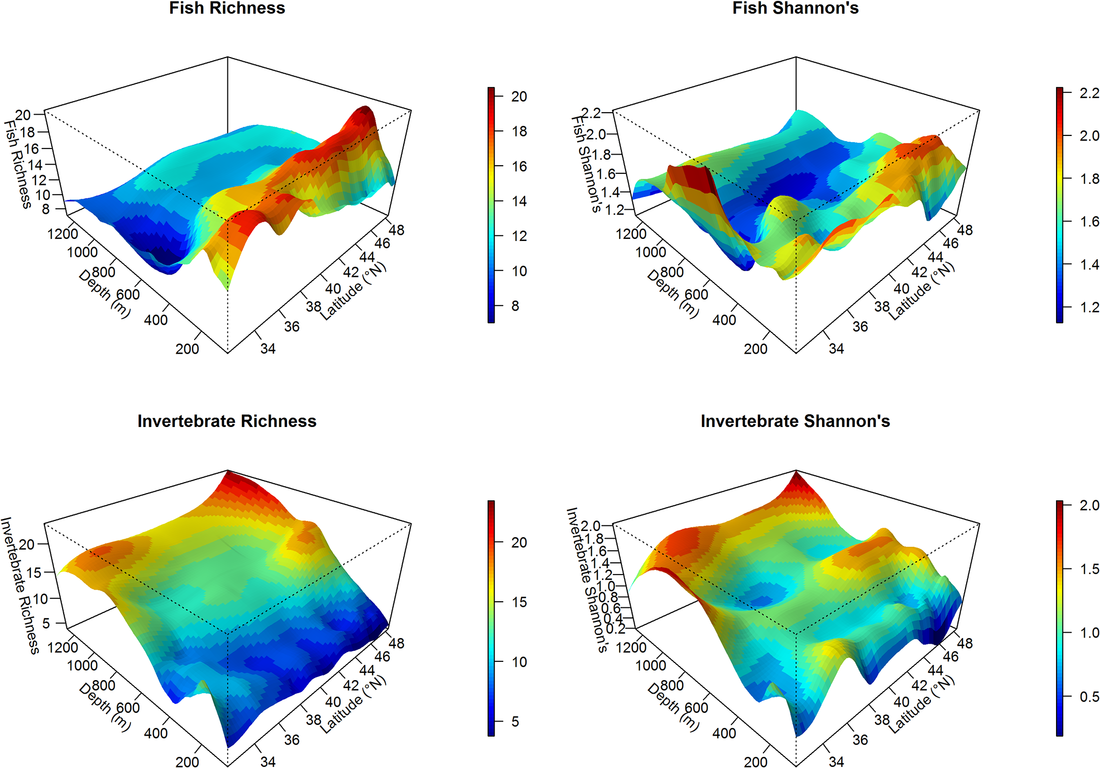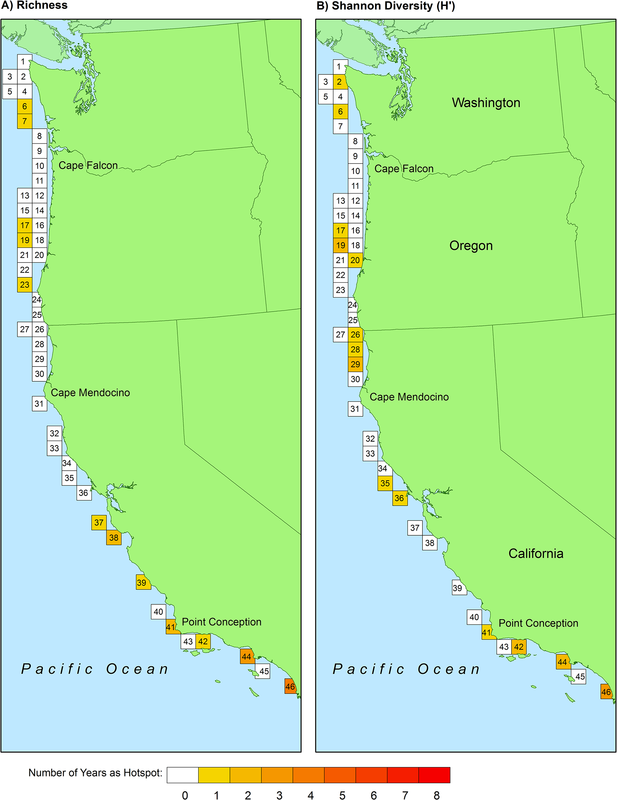|
Investigators: Susan Piacenza, Lindsey Thurman, Ali Barner, Casey Benkwitt, Kate Boersma, Liz Cerny-Chipman, Kurt Ingeman, Tye Kindinger, Amy Jo Lindsley, Jake Nelson, Jessica Reimer, Jen Rowe, Chen Chen Shen, Kevin Thompson, and Selina Heppell (OSU)
During my Ph.D., I was also the Graduate Student Lead on an analysis project as part of the multi-institutional NSF-funded Dimensions of Biodiversity Graduate Seminar (DBDGS; http://grantome.com/grant/NSF/DEB-1050680). This research was a collaborative effort among 14 graduate students and one faculty advisor, across three colleges at Oregon State University. We used data from the US West Coast Groundfish Bottom Trawl Survey (WCGBTS) and worked with NOAA Northwest Fisheries Science Center (NWFSC) biologists responsible for conducting those surveys. Using a variety of spatial analysis tools and multi-variate statistics, we characterized the spatiotemporal patterns of benthic biodiversity along the US West Coast and created an approach to test if biodiversity hotspots are consistent over time. First, we found that benthic biodiversity did not strictly adhere to the latitudinal gradient, and patterns of diversity depended on taxa, latitude, depth, substrate, and year. Next, we adapted an existing tool to objectively identify biodiversity hotspots and assess the consistency of hotspots over time. We created a novel approach to deal with decision points for hotspot definition and methodological steps to prepare our dataset for the analysis. Unexpectedly, we found no areas contained consistently high biodiversity throughout the entire study period based on the mean thresholds, and no grid cell was designated as a hotspot for greater than 50% of the time. Our finding of low temporal consistency in benthic fish biodiversity hotspots was upheld, regardless of biodiversity metric used, whether thresholds were calculated per year or across all years, or the spatial extent for which we calculated thresholds and identified hotspots. Given that ecological communities are responding to a changing climate and other environmental perturbations, our work highlights the need for scientists and conservation managers to consider both spatial and temporal dynamics when designating marine protected areas. In the future, I will continue to pursue this research by applying the biodiversity hotspots consistency tool to other large marine ecosystems and taxa may show a similar lack of temporal consistency, or reveal consistency in diversity patterns that can identify critical areas for conservation. Using additional data from other large marine ecosystems, and including additional biodiversity indices (i.e. functional or phylogenetic diversity) may be helpful in elucidating placement and even timing (e.g. closures to protect temporary mating aggregations or recruitment booms) of marine protected areas. |
- Home
- People
-
Research
- Kemp's ridley Spatial MSE
- Stereo-video Cameras for sea turtle length measurements
- Sea Turtle Behavior at Artificial Reefs
- Patterns and drivers of sea turtle bycatch at fishing piers in the eastern Gulf of Mexico
- Sea turtle Photo ID at Fishing Piers
- Developing a Stereo-video Camera Mounting System for UAVs
- Animal Navigation and Bioinspired Design
- Investigating Design Improvements to Marine Megafauna Tracking Devices
- Sea Turtle Hatchling Dispersal
- Quantitative Tools for Monitoring and Assessment
- Characteristics of High Fish Biomass Rocky Reefs
- Spatiotemporal Patterns of Benthic Biodiversity in the California Current
- Data-poor stock assessments for the Oregon Nearshoore Fisheries
- Publications
- Courses Taught
- Home
- People
-
Research
- Kemp's ridley Spatial MSE
- Stereo-video Cameras for sea turtle length measurements
- Sea Turtle Behavior at Artificial Reefs
- Patterns and drivers of sea turtle bycatch at fishing piers in the eastern Gulf of Mexico
- Sea turtle Photo ID at Fishing Piers
- Developing a Stereo-video Camera Mounting System for UAVs
- Animal Navigation and Bioinspired Design
- Investigating Design Improvements to Marine Megafauna Tracking Devices
- Sea Turtle Hatchling Dispersal
- Quantitative Tools for Monitoring and Assessment
- Characteristics of High Fish Biomass Rocky Reefs
- Spatiotemporal Patterns of Benthic Biodiversity in the California Current
- Data-poor stock assessments for the Oregon Nearshoore Fisheries
- Publications
- Courses Taught


